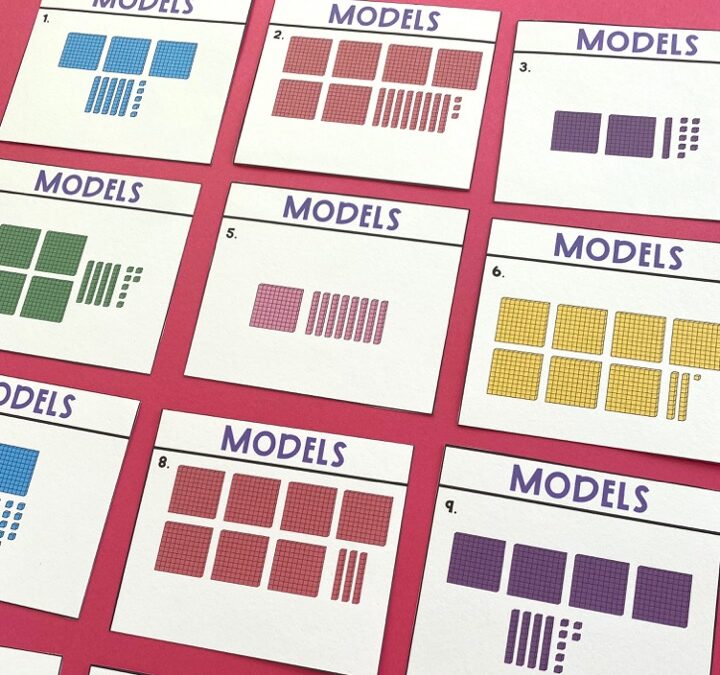Teaching the place value standards to 2nd grade students is crucial. I think place value lessons are some of the most important lessons I teach my 2nd graders. Place value lays a solid foundation of understanding of how our number system works. From place value math lessons, students learn the relationships between digits in a number. They see what each number represents. Not only that, it will help set them up for success with 3-digit addition and subtraction strategies including regrouping.
Because of our number system, it is easy for students to have misconceptions. I once had a student that kept writing 3-digit numbers like 204, 409, and 503 like 24, 49, and 53. They were thinking that sense zero means none or nothing, they didn’t need to write it. But with what we learn from place value, we know that the zero does mean something. It means there are zero tens in that number.
So what are the place value standards for 2nd grade? And what is the best way to teach them so that students understand?
In this blog post, I will be sharing each of the 2nd grade place value common core standards and how I teach them in my second grade classroom. I’ll be sharing the tips and tricks I have learned teaching these place value topics to this age group of kids over the years and the practice activities that engage students.
But first… If you’re a parent who has a child struggling with math, you’ve got to check out Learner. Learner is an online tutoring platform that sets students up for success. To get started take a short quiz about your child’s needs. Then Learner’s Success Management Team reviews that and matches your child with the perfect tutor. Get your $25 trial here.
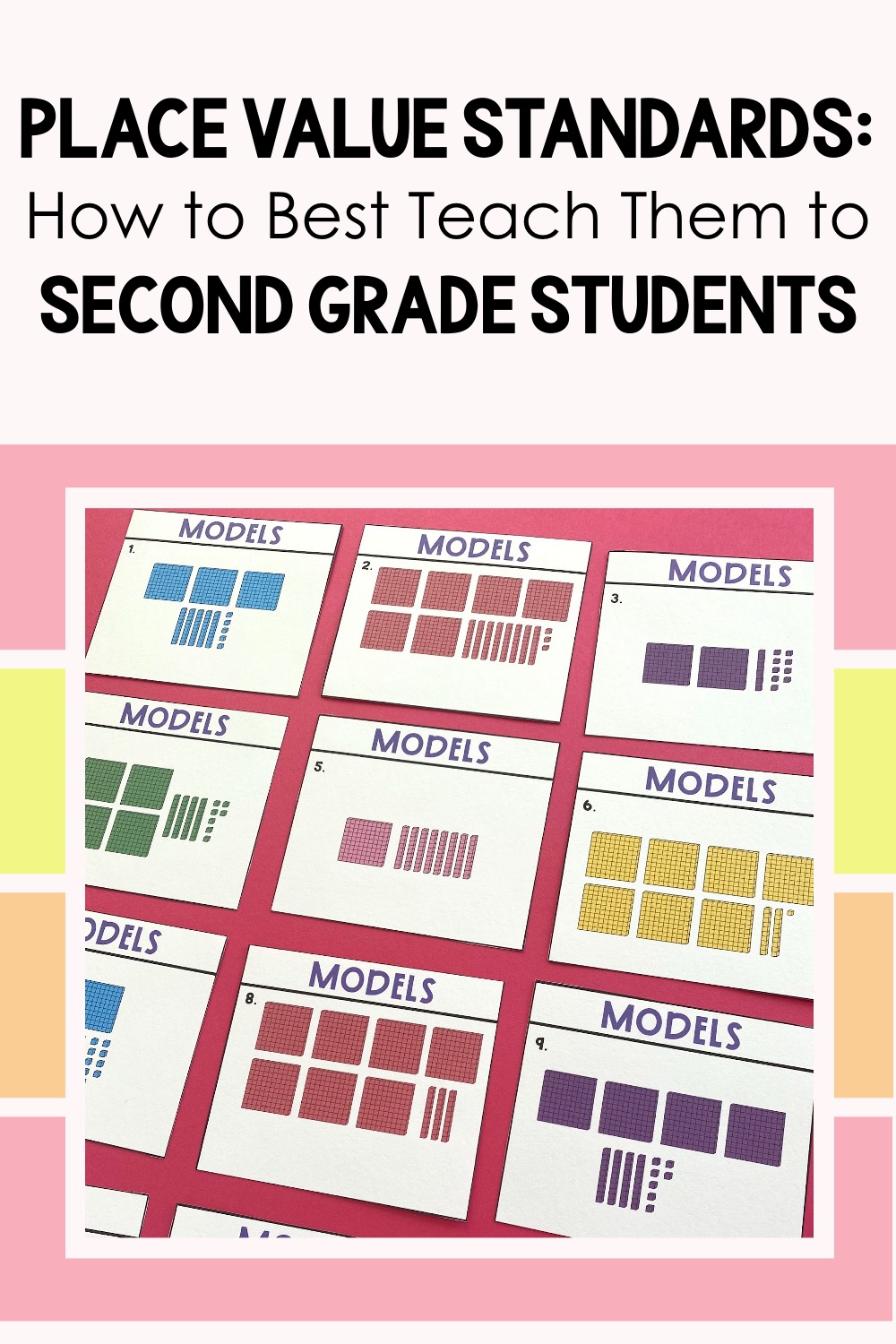
Teaching place value standards doesn’t have to be boring for students. You can get them fun activity with scoot activities and sorting activities.
Place Value Standards
I like to use the CommonCore App to easily have available the place value common core standards for my lessons. These are from that app:
2.NBT.A.1 Understand that the three digits of a three-digit number represents amounts of hundreds, tens, and ones.
2.NBT.A.1.a 100 can be thought of as a bundle of ten tens – called a “hundred.”
2.NBT.A.1.b the numbers 100, 200, 300, 400, 500, 600, 700, 800, 900 refer to one, two, three, four, five, six, seven, eight, or nine hundreds (and 0 tens and 0 ones).
2.NBT.A.2 Count within 1000; skip-count by 5s, 10s, and 100s
2.NBT.A.3 Read and write numbers to 1000 using base-ten numerals, number names, and expanded form.
2.NBT.A.4 Compare two three-digit numbers based on meanings of the hundreds, tens, and ones digits, using >, =, < symbols to record the results of comparisons.
These are the standards, but what is the best way to teach them? I like to break these standards down into 9 lessons on place value topics.
Here are those place value topics:
- Understanding Hundreds
- Models and 3-Digit Numbers
- Name Place Values
- Ways to Write and Read 3-Digit Numbers
- Different Ways to Name the Same Numbers
- Place Value Patterns
- Skip Counting by 5s, 10s, and 100s
- Comparing Numbers Using Place Value
- Writing Numbers That Are Greater or Less Than a Number
Let’s jump into how I teach these place value math lessons. I like to keep the set up and structure of these lessons similar. They turn into a routine. This makes it easier as the teacher because I don’t have to explain every little thing to students. Students know what to do and expect. This structure involves direct instruction & modeling, guided practice, independent practice, and assessment.
Place Value Math Lessons
Understanding Hundreds:
This lesson teaches the 2.NBT.A.1.a and 2. NBT.A.1.b place value standards. I put up a display page that shows 10 ten rods. I have my students count by tens with me and we discover that 10 tens equals 100. We then fill out a chart that I call a “hundreds, tens, and ones chart.” It helps show that 100 has 1 hundred, 0 tens, and 0 ones.
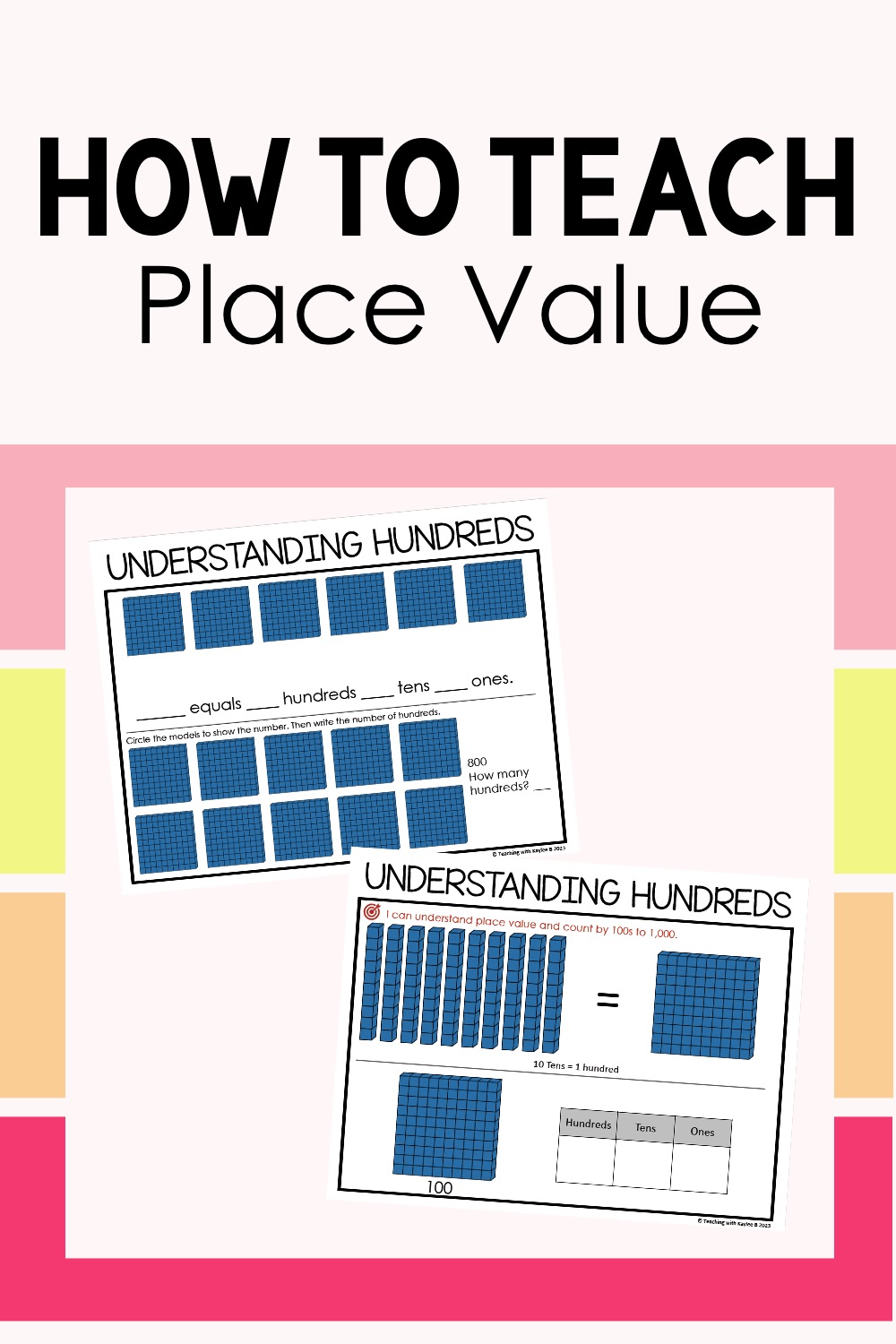
These display pages make it so easy for me to teach important place value standards. It guides me on what to say and teach to my 2nd grade students.
Then we practice a couple problems where it shows a model of 600 with base ten blocks. Students tell me the number, 600, and then tell me how many hundreds, tens, and ones it has. The other problem has a bunch of hundreds blocks displayed and we circle as many as we need to make 800. Then they say how many hundreds it says. I like doing these couple of problems together because they match the worksheets I have students do. This helps them know how to complete the worksheets.
The worksheets are great as guided practice and independent practice. I pass out the worksheets. We do the first couple of problems together and then students do to rest by themselves. Once they are done, students come to me at my table and I quickly check their answers and help on anything they missed. I give them a check mark on the top of their page and then they put them in their folders to take home.
I love checking my students’ work with them because I can give immediate feedback and I save time by not correcting papers after school and sorting their papers for them to take them home.
After that, I have students get with a partner and do a scoot activity around the room. I have task cards taped up around my classroom. Students get a recording sheet and go around solving the different problems around the room. Afterwards, they check their answers with an answer key.
Then I give them a place value puzzle to work on. Students still work with their partners to complete this. They find a place on the floor and spread out the pieces. This puzzle has the top part showing a hundreds number with base ten blocks. Then students have to match other parts that match with that hundreds number. For example, one of the pieces will have 3 hundreds blocks on the top. Then students have to find the piece that says “300” to match with it. They match a piece that says “3 hundreds” and a piece that has “100, 100, 100” with it. Students find these puzzles really fun and engaging! When they finish, students raise their hands and I come by to do a quick check. Then they mix up and stack up the pieces so that they are ready for my students next year.
Lastly, students complete a little exit ticket. They rate themselves on how they understand the concept taught, and complete 2 problems. Then I check these later to see how students have mastered the lesson and the place value standard.
Find my display pages, worksheets, scoot activity, puzzle, and exit tickets here.
Models and 3-Digit Numbers:
This lesson follows the main place value standard: 2.NBT.A.1 Understand that the three digits of a three-digit number represents amounts of hundreds, tens, and ones.
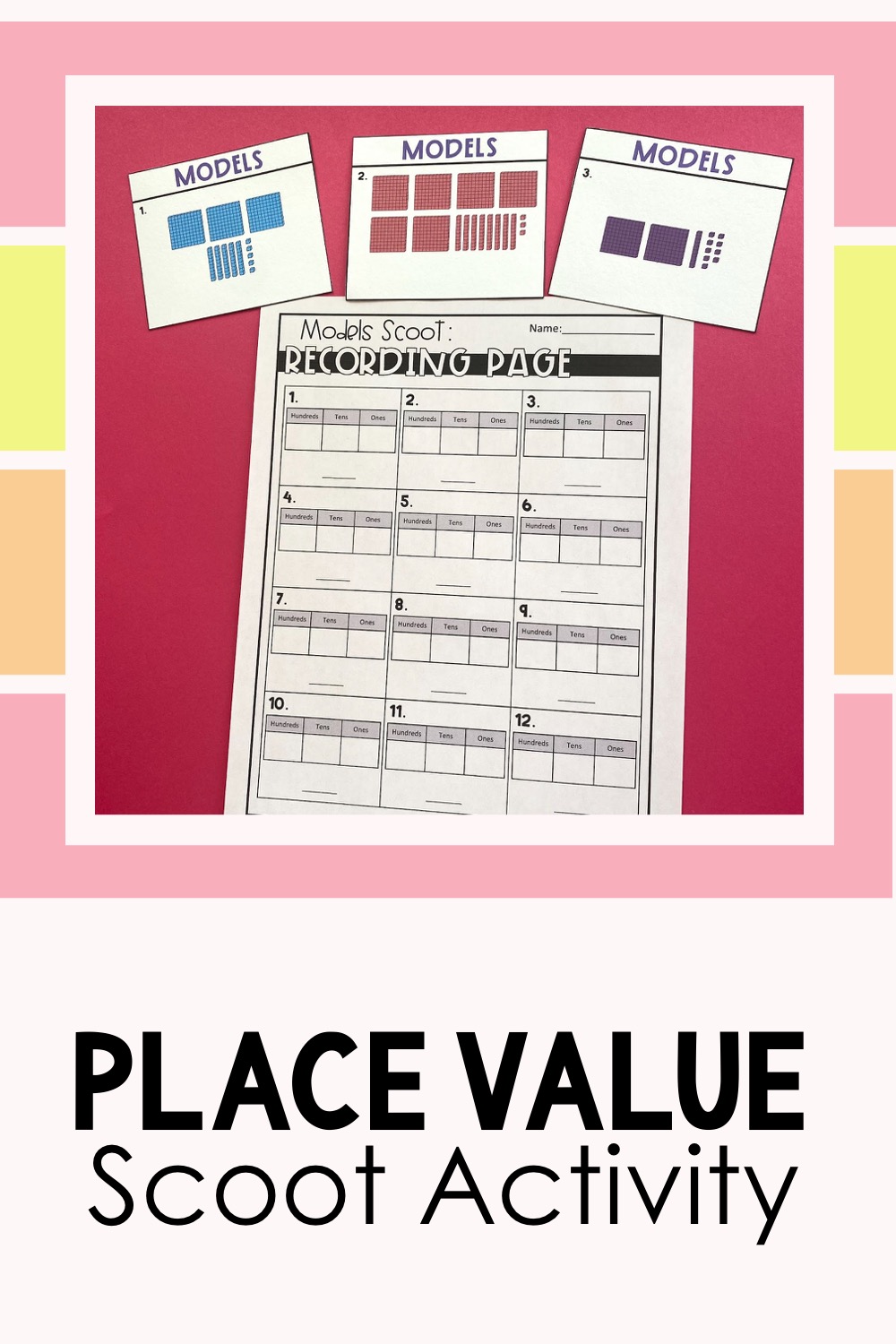
I like students to work with a partner to complete scoot activities. That way they are talking about the math and these place value standards.
This lesson has the same outline of the one mentioned before: display pages for direct instruction, worksheets, scoot activity, and a puzzle for guided practice and independent practice, and exit tickets for assessment.
For my display pages, the first page shows a model of a 3-digit number. I show students how to count the hundreds, tens, and ones, and put those numbers in a hundreds, tens, and ones chart.
I also show examples where there are 0 tens or 0 ones. Students are able to see that we need those zeros in the 3 digit number.
It’s important to show a 2-digit number so students can see if we have 0 hundreds, we don’t need that zero out front. It just means that the number is a 2-digit number.
After that we do a couple practice problems together as a class. Remember these are similar problems to the ones on their worksheets. This helps scaffold the work for them. That way when they get their worksheets, they know what to do.
Students then complete the worksheets, scoot activity, puzzle, and exit ticket. Find these resources here.
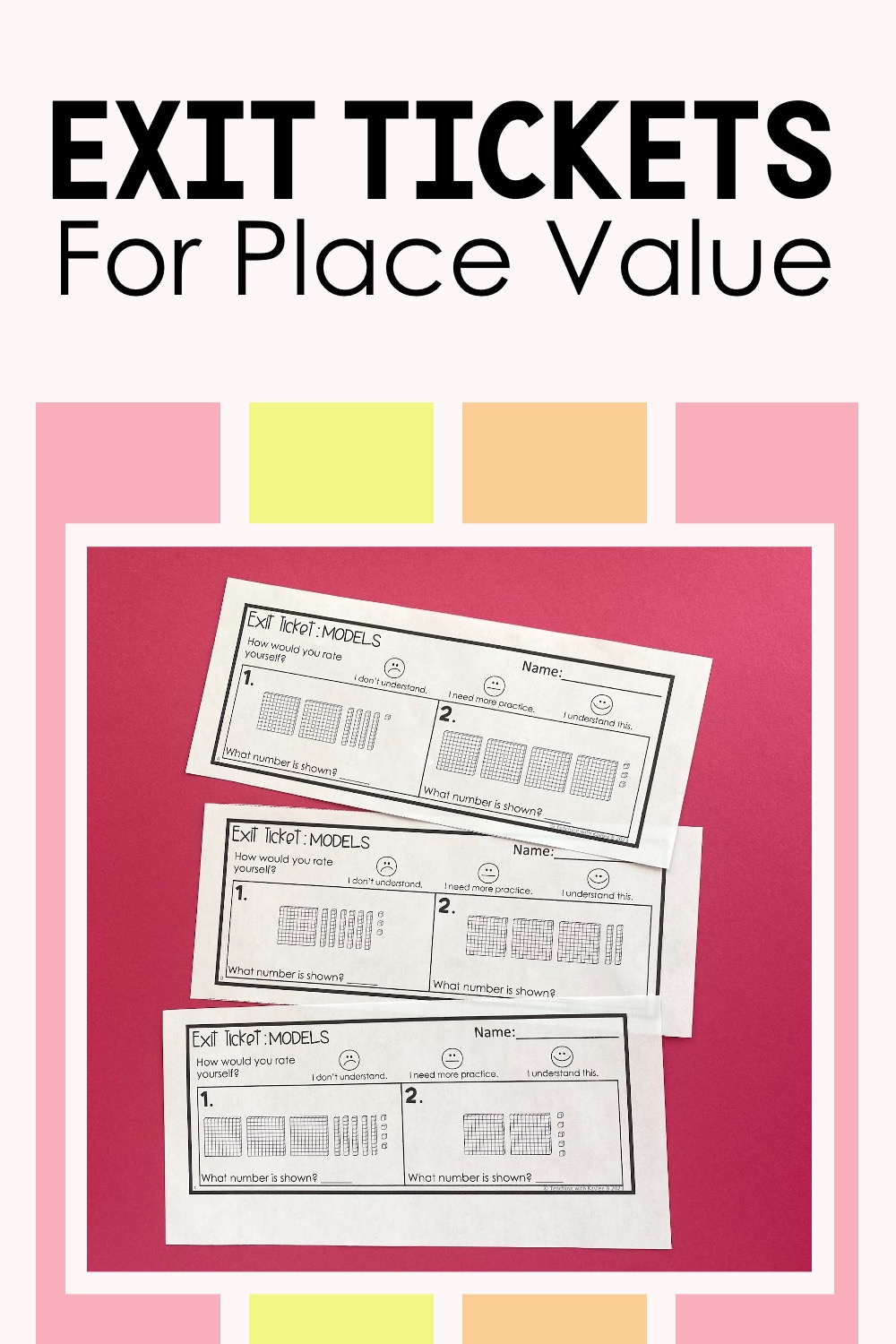
Using exit tickets easily allows me to see which students understand the place value common core standards I taught and who may need a little more practice.
Remember, you don’t have to do all of these activities during this lesson. The scoot activity and the puzzle are great as center activities as well!
Name Place Value:
For this lesson, I want students to know the value of the digits in a 3-digit number. Where the digits are placed determines their place value. For example, the 3 in 132 doesn’t mean 3, it means 30 or 3 tens.
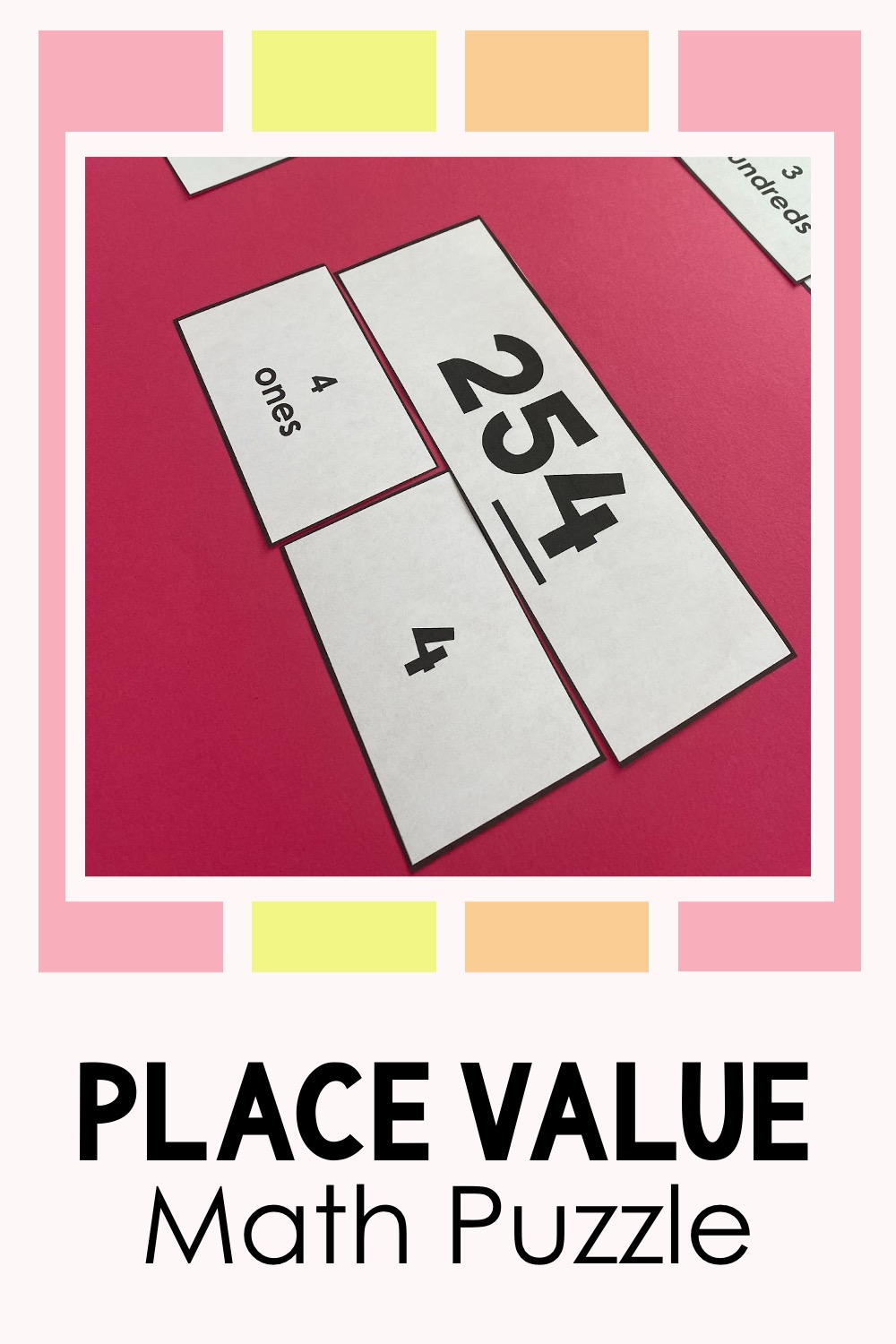
My students love these place value puzzles! It’s an engaging part of our place value math lessons.
I display a page that shows this to my students with the hundreds number, the tens number, and the ones number. It has a picture of the base ten blocks so students can really see the value. Then we practice a few problems together where they tell me the values of the underlined digit in the 3-digit numbers. Then I get students practice with this place value standard with worksheets, a scoot activity, a puzzle, and then assess them with an exit ticket. Find these resources to use in your classroom here.
Ways to Read and Write 3-Digit Numbers:
This lesson follows this place value standard: 2.NBT.A.3 Read and write numbers to 1000 using base-ten numerals, number names, and expanded form.
I display a page where it shows a model of a 3-digit number. Then it shows the standard form. I tell my students that standard means normal. So this is just the normal way to write the number. Then I show them the expanded form example. I tell students that this is where you take the value of the digits and put a plus sign in between. So 471 is 400 + 70 + 1. And lastly, I show them an example of the word form. I simply tell students that this is where we write out the words we say when we say the number. It’s important to show students that numbers like seventy-one, twenty-four, fifty-six have that dash between the words.
Students often get concerned with the word form because they don’t know how to spell the numbers. I have a Spelling Dictionary for each one of my students that I give them at the beginning of the school year. They keep these in their desks and can pull them out whenever needed. There is a page in there that shows how to spell all the numbers they need for these problems. Find the Spelling Dictionary I use here.
After I show students those examples, we work on some examples together where we write the standard form, the expanded form, and the word form of different 3-digit numbers.
Then students are ready for their practice activities. Remember these include worksheets, a scoot activity, a puzzle, and exit tickets to assess. Find these resources here.
Different Ways to Name the Same Numbers:
I love this lesson because it helps students be flexible with 3-digit numbers. I put up my display page where it shows the number 245. Then it has a chart with way 1, way 2, and way 3. I only focus on these 3 ways with my students.
Way 1 is just regular expanded form. The chart also shows the model of the number.
Then I remind students that 10 tens equals 100. So we can take one of those hundreds from 245 and give it to the tens. There is also a model that shows 1 hundred block, 14 ten rods, and 5 ones. We write the equation to represent this as 100 + 140 + 5.
For way 3, I remind students that 1 ten equals 10 ones. Students see that for this way we give a ten to the ones. I show them the model for 245 that has 2 hundred blocks, 3 ten rods, and 15 one cubes. Then we write the equation to represent this as 200 + 30 + 15.
All 3 ways equal the same number. Then we practice a couple problems together where they give us the standard form of a number and we write the 3 ways to name that number using those equations mentioned above.
Then students are ready for the practice activities. I like to keep up that display page with the chart that shows all three ways. This is helpful for students to reference to as they are doing the worksheets, scoot activity, puzzle, and exit tickets. Find these resources here.
Place Value Patterns:
I love this lesson because this one really gives the students skills for adding and subtracting 3-digit numbers on a number line later on in the school year.
For direct instruction, I display a page that has a hundreds chart but the numbers range from 101 to 160. The first half of the chart has all the numbers. I ask students what patterns they see. I want them to notice that if we go one to the right, the ones number is one more. If you go one left on the chart, the number in the ones number is one less.
I also want students to notice the patterns when they go up or down on the chart. If you go down, the number in the tens place is one more. And if you go up one, the number in the tens place is one less.
On the bottom half of this chart, there are some missing numbers. Students help me use the patterns we just learned to write in the missing numbers.
We practice a few different problems together where we have larger numbers in the chart. Then students are ready for their practice activities. Like all the lessons I’ve shared before, I have my students do worksheets, a scoot activity, a matching puzzle, and exit tickets for a quick assessment. Find all of these resources here.
Skip Counting by 5s, 10s, and 100s:
Skip counting is a skill we use pretty regularly in our daily lives. That is why this is one of my favorite place value standards to teach.
For this lesson, I display a page that shows counting by 5s, 10s, and 100s. Then I ask students what patterns they see for each one. Skip counting is fun for students because once they learn those patterns, it’s easy!
Then we do a couple practice problems together where students have to look to see if they are counting by 5s, 10s, or 100s and then give the next number.
After that, I give my students lots of practice like the lessons I’ve talked about before. The only thing that is a little different is that instead of having my students do a puzzle activity, they do a sorting activity. They sort cards on whether the example is counting by 5s, 10s, or 100s. This activity really helps students practice finding and using those patterns.
Find all the resources to teach this place value standard here.
Comparing Numbers Using Place Value:
Comparing numbers is also such an important place value standard because we do it so often in our daily lives. To help students think about this I will say something like, “Would you like someone to give you $180 or $170?” Students will say $180 and I will ask them why. They usually will say something like, “because $180 is more.” I then explain that another way to say that is to say that $180 is greater than $170. Then I show that a way to show that with math symbols is to use the greater than sign.
Then I display the page that shows the greater than sign, the less than sign, and the equals sign. I note to my students that “>” and “<” look similar but that we can remember that “<” is less than because it is a squished down “L.”
I personally don’t have my 2nd grade students use the “alligator trick.” I would rather have them use the language of the signs. I have them read the comparison like a sentence. We practice this together and I display the signs so students can reference them. Students catch on really quickly.
I want students to understand how place value helps with comparing numbers. We start with the hundreds numbers to compare first. If those are the same, we move to the tens numbers. If those are the same, we move to the ones numbers. When students put the 3-digit numbers into “hundreds, tens, and ones charts” it helps them see this easier.
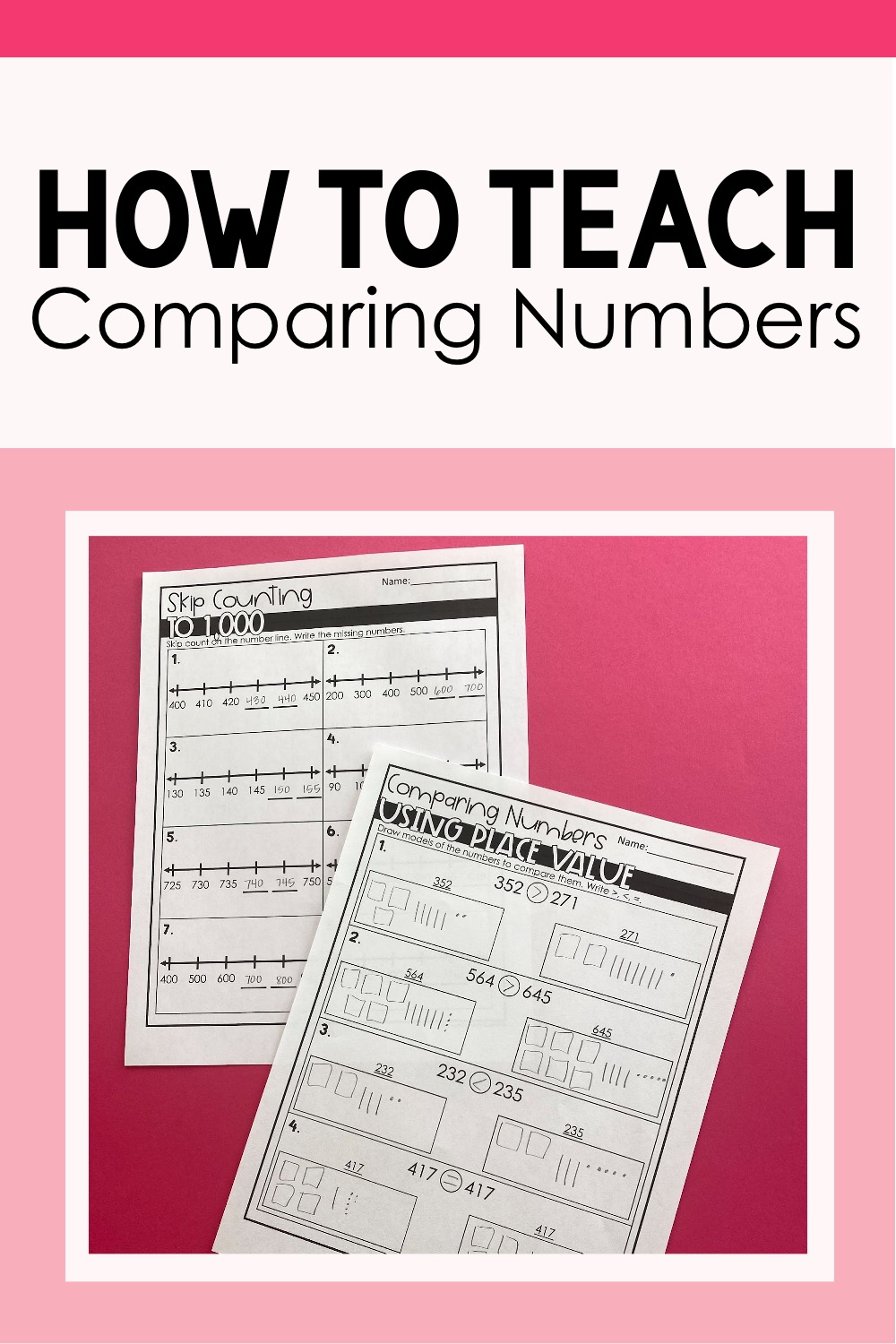
Comparing numbers can be tricky for students. But having them draw out the models or use a hundreds, tens, and ones chart helps them understand this place value standard.
After we practice some problems together, students are ready for their own practice. They get practice with worksheets, a scoot activity, and a sorting activity. The sorting activity has students sort cards on whether it is greater than, less than, or equal to. Then I assess how students understand this concept with an exit ticket. Find these resources for comparing numbers here.
Writing Numbers That Are Greater or Less Than a Number:
This lesson is a continuation of the last, but now students have to think of a number to make the comparison true. So a problem might look like this: ___ < 762
I have my students read it like a sentence, “blank is less than 762.” Then I ask what is a number that is less than 762.
We practice this with problems with less than and greater than signs.
Then students are ready for their practice activities of worksheets, a scoot activity, and a sorting activity. The sorting activity gives comparisons but some are correct and some are incorrect. Students read the comparisons like a sentence and then sort the cards. Find these practice activities here.
I also have a fun game that I surprise students with. I call it Place Value War.
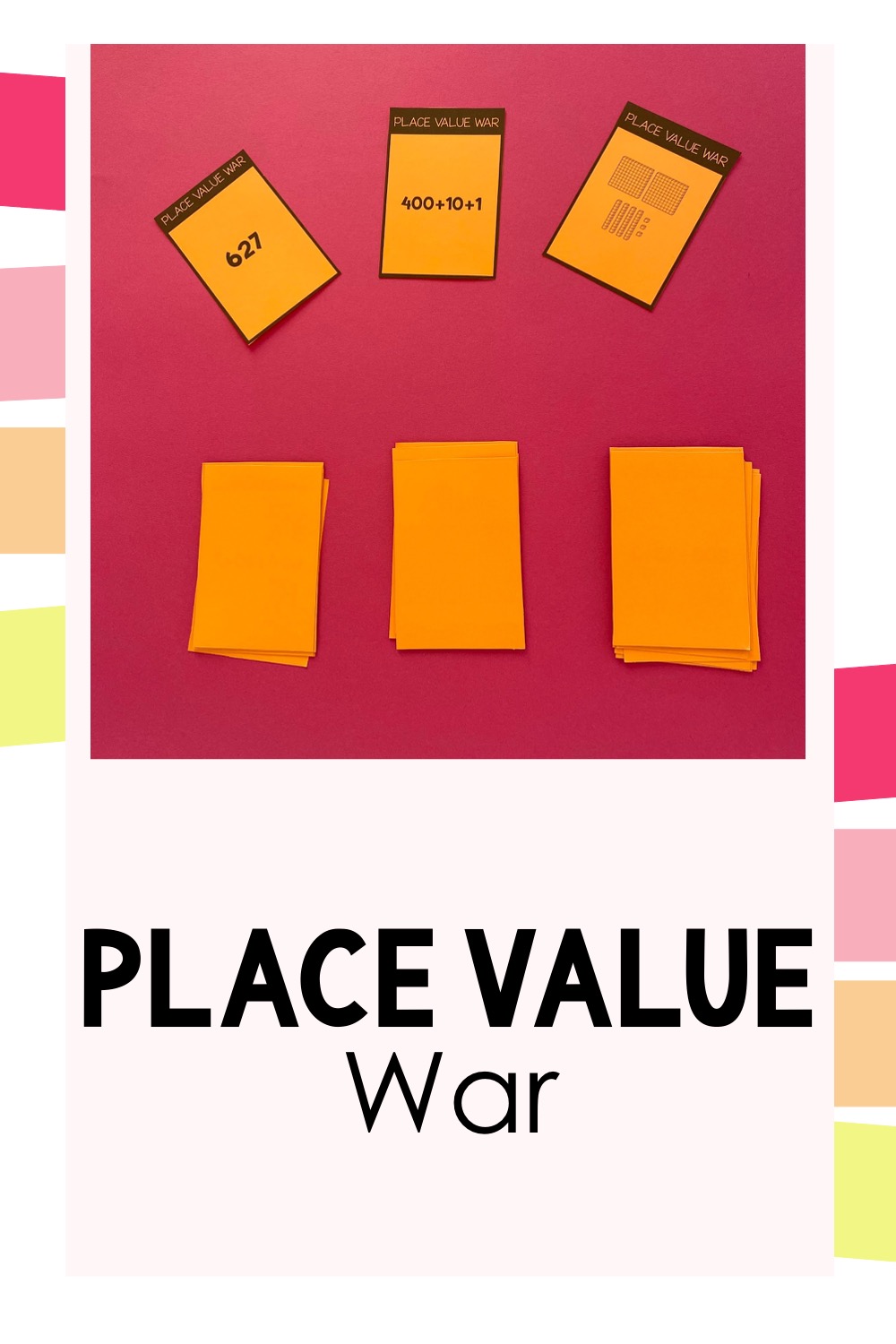
Place Value War is one of my 2nd grade students’ favorite place value games and activities!
This is like playing regular war but with the cards, some have the standard form of numbers, some have a model of the numbers, and some have the expanded form of the number.
I have students play in groups of 2-4. Students pass out the cards and put their stack in a pile face side down so they are not looking at their cards. On the count of 3, the players flip over their top card. They look at the numbers and compare them. The player with the card that has the greatest number wins the round and gets to take those cards and put them at the bottom of their stack. Students continue playing until the teacher says time is up. The player with the most cards wins!
Students absolutely love this game. I love to leave it out as a fast finisher activity for my students. That way they get in extra practice when they finish assignments.
This Place Value War game is part of my resource with all my other place value resources. Find it here.
After teaching all of these place value concepts, I have students take an assessment over place value. This test has similar problems to the ones students practice with on their worksheets and scoot activities. This helps me get an overall idea on how students understand place value. It also helps me get a grade for the grade book. Find the assessment that I use here.
Place value is so important for 2nd grade students. As you have read through how I teach each of the place value standards, I hope you have been able to see how it can be so helpful to students.
When students understand that 10 tens make up a hundred, it will help when I teach 3-digit addition and subtraction with regrouping. Because students know how to read the expanded form of a 3-digit number, it will help them add and subtract using partial sums and differences. It helps students so much to add and subtract on a number line when they know place value patterns. When students are flexible with 3-digit numbers, it helps them with mental strategies to add and subtract 3-digit numbers. Whatever you teach in place value, it will help students in the long run.
My place value games and activities resource gives you everything you need to teach all of the place value common core standards for 2nd grade.
It includes display pages so that you can easily teach the place value concept with no prep. It gives you worksheets that are great as guided practice or independent practice. It gives you the scoot activities I mentioned above and all of the fun puzzles, sorting activities, and games for students to get even more practice. Then it gives you assessment tools like the exit tickets and unit assessment. I love using this resource for my formal observation each year because it has everything I need to get a good score! Find this resource to use in your classroom and to save you time here.
If you like these place value activities, you will love the activities and games I have my 2nd grade students do to practice counting money and telling time. Read about these here in these blog posts:
5 Money Games and For 2nd Grade That Students Love
5 Telling the Time Activities to Help Students Understand Analog Clocks


